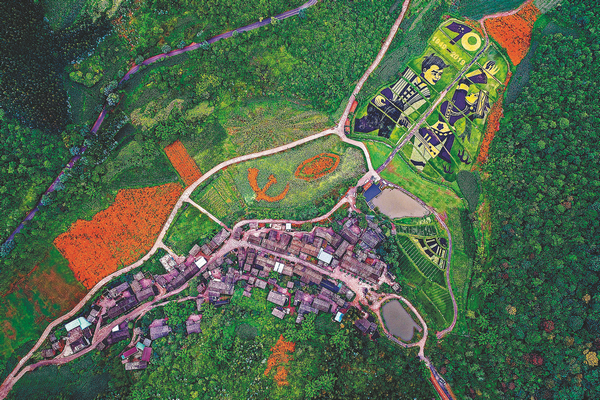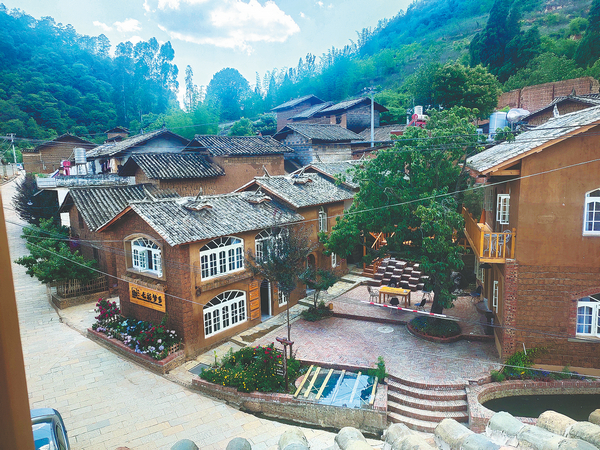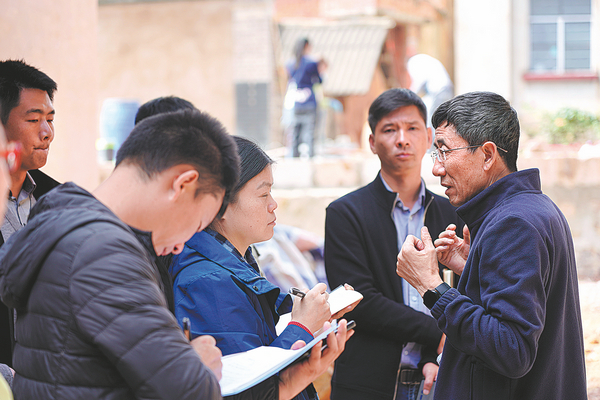
A panoramic view of Maidichong village features paddy fields decorated into elaborate artworks by cultivating the rice seedlings. Agriculture-based tourism has helped to attract visitors to the village in Yiliang county, Kunming, Yunnan province.
Experts from China Agricultural University help remote Yunnan village become a model of vitalization and innovation, report Yang Feiyue in Beijing and Li Yingqing in Kunming.
A small village, way off the beaten track, has been turned into a model of rural vitalization and innovation.
Two years ago, residents at Maidichong village wouldn't have dreamed their home would be known among urban travelers. The village in Yiliang county is about 90 minutes' drive from Kunming, capital of Southwest China's Yunnan province.
"Everything was a mess and chaotic," says Pan Yunchun, a local villager, adding that the sewage flowed everywhere and the manure of farm animals could be seen everywhere.
"It was all mud roads."
The village is just about 3.5 kilometers away from the Jiuxiang scenic spot, a well-known tourist attraction in Kunming. However, the undesirable conditions in the village failed to entice travelers.
Things took a turn for the better in 2019 when experts from China Agricultural University moved in and started offering guidance.
It was part of the local authority's efforts to transform Maidichong into a rural getaway and improve the lives of local villagers. It didn't take long for Maidichong to say goodbye to its chaotic and scruffy past.
Experts from the university have studied and dealt with major problems in rural areas surrounding Kunming and, every year, postgraduate and doctoral candidates have been dispatched to conduct field studies and offer intellectual support to local governments and rural businesses.
"Cities and villages should not be the opposite of each other, but should be a fusion," says Li Xiaoyun, who headed the team of experts.
Those experts have endowed the labor force at Maidichong with an injection of scientific and technological strength. They taught villagers how to cultivate colored rice seedlings, and prearranged a pictorial pattern on doing so. When the rice is mature in autumn, the crop will form a pattern, which creates a picture-perfect backdrop to social media posts.
In fact, the move helped the village to draw in more than 100,000 traveler visits in 2019.
That initial taste of success stimulated further action. Themed pastoral scenery, featuring local ethnic Yi elements and flying peacocks, was put in place and focus has been given to vigorously developing agricultural tourism that highlights blossoms and fish farming in the paddy fields.

Rural facilities in Maidichong village are turned into homestays. [Photo/CHINA DAILY]
To date, local villagers have cultivated 10 hectares of marigold and a 13.3-hectare demonstration zone where rice paddies and fish coexist.
When visitors stroll among the rice paddies, the fragrance of marigolds permeates the air while fish jump to catch bugs from the surface of the water. In winter, the straw will be bundled and turned into artworks of various shapes and sizes. Visitors can get a panoramic view of the whole rural scene from a specially erected sightseeing platform.
Travelers have been flocking to the village to enjoy the natural colors and scents of autumn, especially during August and October, according to the local authority.
However, as visitor numbers began to surge, problems of accommodating them soon followed.
"We had limited reception capacity for the tens of thousands of travelers coming here right after the colorful paddy field scenery took shape," says Kou Cunlin, head of the village.
Li led a team to study rural houses that lay idle across the village. Owners were paid by the village cooperative to rent them and turn them into distinctive homestays.
The idea is to retain all the benefits within the village.
Kou helped with Li's initiative and they managed to find seven idle tobacco flue-curing houses and six livestock facilities.
Those old houses were renovated with new paint and fresh exteriors, while keeping most of their original structures and surrounding environment.
Public toilets, a sewage treatment station and auxiliary pipelines have also been developed to improve the experience of visitors, as well as conditions for the villagers.
The move has encouraged more villagers to offer up their old properties to be repurposed.
"There are about 40 households that have expressed interest in renting out their old houses to the village cooperative," Kou says.
At the same time, a company was established by the village cooperative to use the rural tourism profits to develop a collective economy and pay dividends to villagers.

Li Xiaoyun (right) from China Agricultural University heads a team of experts to implement rural vitalization in Yunnan province. CHINA DAILY
Pan is one of those who benefit from the "rural CEO program", where the local authority has set up a talent cultivation fund and encourages villagers to become leaders who know both the city and the village-and how to connect them.
The 35-year-old started up a small restaurant in the central area of Yiliang county in 2017, but didn't enjoy brisk business.
He sensed the change at Maidichong, where he was born and grew up, when he visited the village and saw that buses and private cars had begun to make their presence felt in the neighborhood.
Pan bit the bullet, closed his restaurant and joined the CEO program, which he considered to be a great opportunity for his home.
"Professor Xiaoyun told us that we have to activate idle property for village development, so that tourists would visit restaurants and book homestays for their stay after seeing the colorful paddies," Pan says.
"It is harder than running a small restaurant, but I will see it through," he says.
"The local government has provided special support to rural vitalization, so I can see the future of our village. I believe more travelers will come."
He has already noticed the increasing number of visitors, and the positive changes that are happening to cater to their needs.
"Leisure venues, such as homestays and coffee shops are in the works," Pan says.
"The living environment in the village has been improved, and the rural planning is also very clear," says Pan.
The number of rural homestays has been on the rise.
Pan is currently running 26 beds and says he expects that number to break 40 soon.
Compared with the traditional local economy, which relied on plantations, agriculture-based tourism has greatly increased the income of the villagers, says Zheng Yuzhu, an official from the Kunming Bureau of Agriculture and Rural Affairs.
Locals used to grow tobacco for a living and get an annual income of no more than 40,000 yuan ($6,284).
Now, many of them have opened restaurants and sell farm produce to visitors without having to leave home, Zheng adds.
Some restaurant owners can bring in about 200,000 yuan annually, according to Kou.
To spice up traveler experiences further, a camping and torch carnival and a colorful rice paddy planting festival have been staged.
E-commerce has also been developed to promote local farm produce and broaden its sales channels.
Pan is optimistic about the future.
"The infrastructure has been upgraded, tourism projects are maturing and the lives of the villagers will be better," he says.